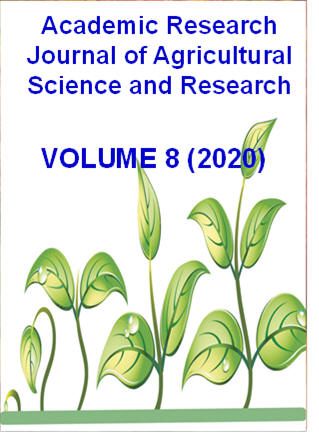|
ISSN: 2360-7874 |
Academic Research Journal of
Agricultural Science and Research |
|||||||||||||||||||
|
Vol. 8(5), pp. 453-460, June 2020 Review Effect of micro nutrient composition of leaves of mulberry (Morus indica) varieties on growth and cocoon yield of bivoltine mulberry silkworms (Bombyx mori L.)
Kedir Shifa*, Metasebia Terefe, Ahmed Ibrahim, Abiy Tilahun and Yohannes Nugusu
Melkassa Agricultural Research Center, P.O.Box 436, Adama, Ethiopia *Corresponding Author: Kedir Shifa, Melkassa Agricultural Research Center, P.O.Box 436, Adama, Ethiopia. Tel: +251911384487, E-mail: kedirsh01@gmail.com
Accepted 15 June 2020
The growth, yield and reproduction potential of silkworms can be affected by their feed sources to a great extent. Micronutrients are among important biochemical components of leaves and they may have very big influence in productivity of silkworms. In the present study, six different mulberry varieties (K-2, S-13, M-4, Nekemte coll, Jimma Coll and Local) were evaluated for their leaf composition and effect on mulberry silkworms (Bombyx mori L.) in Melkassa Agricultural Research Center (MARC), East- Shewa zone of Oromia Regional State, Ethiopia. Completely Randomized Design (CRD) with three replications was employed for carrying out feeding trial in a laboratory. The leaf micro-nutrient composition of mulberry varieties for sodium, copper, iron, zinc, manganese and molybdenum was determined by using appropriate methodologies. The relationship of micronutrient components of leaves with silkworm parameters was also determined by using correlation coefficient analysis. Overall data analysis was carried out by using SAS software at 5% probability level. Finally, the leaves of these varieties showed significant differences among themselves in their micronutrient compositions. Their effect on rearing performance of mulberry silkworms was also statistically different when they were fed. Generally, relationship of micronutrient constituents of mulberry varieties with rearing performance of mulberry silkworms showed positive correlation with manganese, molybdenum and zinc contents with larval, cocoon and grainage parameters of mulberry silkworms. However, iron content was found to affect these silkworm parameters negatively. Therefore, it can be concluded that among micro-minerals in mulberry leaves, the presence of higher managanese, molybdenum and zinc contents and lesser iron content will be helpful to the gain better mulberry silkworm productivity. As a result, these micronutrients will be considered as basic parameters for evaluation of mulberry varieties for mulberry silkworms rearing in the future.
Key words: Mulberry silkworms, Bombyx mori, Micro nutrient, Correlation
How to cite this article (APA Style): Kedir S., Metasebia T., Ahmed I., Abiy T., Yohannis N (2020). Effect of micro nutrient composition of leaves of mulberry (Morus indica) varieties on growth and cocoon yield of bivoltine mulberry silkworms (Bombyx mori L.). Acad. Res. J. Agri. Sci. Res. 8(5): 453-460
|
|||||||||||||||||||
